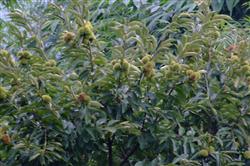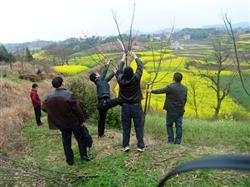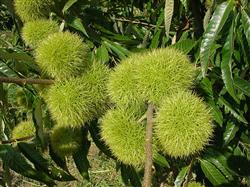How to apply biogas manure to chestnut trees

How do chestnut trees apply biogas manure? Please introduce that the growth of Chinese chestnut requires nitrogen, phosphorus, potassium, calcium, iron, boron and other nutrient elements, and requires the soil to be permeable and breathable, with good performance of water and fertilizer conservation. Growing Chinese chestnut with biogas fertilizer can meet most of the nutrients needed for its growth. Biogas fertilizer is rich in nitrogen, phosphorus, potassium, calcium, magnesium, iron and other elements, as well as a large number of organic matter, a variety of amino acids and vitamins. At the same time, the application of biogas fertilizer can significantly improve the soil, ensure a good micro-ecological environment for the growth of Chinese chestnut, enhance its ability of frost resistance and drought resistance, and reduce diseases and insect pests. Practice has proved that the application of biogas fertilizer can increase the yield of Chinese chestnut by about 20% compared with the conventional planting method, and the fruit is large, uniform in weight, sweet in taste, good in color, resistant to storage and transportation, and has little difference between big and small years. The specific methods of using biogas fertilizer to grow Chinese chestnut are as follows: 1. Re-apply postharvest base fertilizer. The application of base fertilizer should be selected after the chestnut harvest, usually before the end of October. With the dripping of the tree crown as the boundary, a fertilizer application ditch about 70 cm wide should be excavated in a ring, and 70 kg of biogas fertilizer should be applied to each tree (which can be increased or decreased appropriately according to the number of fruits and the size of the crown in the current year), and borax can be mixed with biogas dregs in a constant amount. The soil should be covered after fertilization. 2. Apply budding fertilizer before flowering. In April, shallow trenches of about 30 cm in depth and 30 cm in width were dug around the dripping water of each crown, and about 100 kg of biogas liquid and 0.3 kg of borax were applied to cover the soil quickly. at the same time, the crown was sprayed with clarified and filtered biogas liquid. Once every 10 days or so. 3. Full application of strong fruit fertilizer at flowering stage. From June to July every year, the number of chestnuts needs more nutrients due to flowering and fruit growth. at this time, shallow ditches with a depth of about 20 cm and a width of about 20 cm are dug at the crown drip circle, and about 50 kg of biogas liquid is applied, plus 0.5 kg of potassium dihydrogen phosphate. At the same time, biogas liquid is sprayed on the crown leaves, once every 10 days. If it is applied once in the full flowering stage and fruit expansion period, combined with spraying Zhuangguotiling, the effect is better. 4. Precautions: (1) when spraying chestnut leaves with biogas slurry, the biogas slurry from the biogas digester that normally produces gas for more than three months must be used, and the biogas slurry must be clarified and filtered for 3 days; (2) foliar spraying should be carried out in sunny or cloudy days without wind, preferably in the morning or evening with high humidity, but not in rainy days or sunny days when the temperature is high at noon. (3) foliar spraying should focus on the back of leaves; (4) determine the amount of fertilizer application and operation skills according to the growth of fruit trees: generally speaking, those with poor growth should be re-applied, those with good growth should be applied lightly, those with senile trees should be re-applied, and those with more fruits should be applied lightly. light application with less fruit; in operation skills, special attention should be paid to the excavation of fertilization ditches should not damage the roots, repeated excavation should pay attention to rotation displacement. Click to get more chestnut planting techniques click to get more fruit planting techniques
- Prev

How to trim the chestnut tree?
How to trim the chestnut tree? Please give guidance to chestnut trees can refer to the following methods for pruning: first, the tree shape of young tree pruning chestnut is mainly natural happy shape and trunk sparse layer shape. 1. Natural happy shape: this shape has no central stem, only 3 Mel 4 main branches, natural trunk oblique outward, crown short open.
- Next

How to manage the fruit expansion period of Chinese chestnut?
How to manage the fruit expansion period of Chinese chestnut? Please introduce that summer and autumn is the period of rapid expansion of chestnut fruit. It is necessary to strengthen the management of fertilizer and water and the prevention and control of diseases and insect pests in order to make the fruit fully enlarged, the pulp is full, the fruit does not drop in the middle stage, and the fruit quality is good, so as to obtain high yield and high quality. The specific management measures are as follows:.
Related
- Moge, come on! The staff of the peasant association in the producing area of cantaloupe were frightened when the crowd gathered.
- Causes and Solutions of low Fruit setting rate of Apple
- Symptoms and control measures of passion fruit virus disease
- Fruit growing lesson: how do apple orchards keep high yields?
- Can you build orchards in the mountains? What are the pros and cons?
- How to manage the coloring period of Crisson grape?
- This paper introduces the processing technology of two kinds of fig products.
- How much is a month for retired teachers in rural areas by 2020?
- How can strawberry planting increase sugar content? We should pay attention to management in many aspects.
- What are the cultivation techniques on how to improve the yield of golden fruit?

